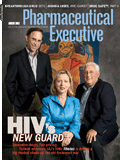Avandia Sales Away
Pharmaceutical Executive
Avandia's market share erosion was magnified further by the almost complete absence of new prescriptions being switched to Avandia from its competitors. In the weeks before the event, Avandia accounted for more than 20 percent of all switches by primary care physicians
Even as the dust settles surrounding the publication of Dr. Steven Nissen's meta-analysis on Avandia's safety risks in the New England Journal of Medicine (NEJM), the jury is still out on the merit of the science. And even though GlaxoSmithKline's market capitalization plunged $14 billion in 48 hours—and analysts are forecasting that the company will lose more than a billion dollars—it seems the industry's only definitive lesson coming from Avandia is in the market's reaction to the news.
It's not the first time we've seen the market overreact to news of negative side effects. Media coverage seems to drive this response by presenting research results without much context and, in the process, scaring patients. But what may be surprising, as is the case with Avandia, is the complexity of the dynamics that underscore that reaction. Physicians don't tend to change prescribing behavior based on one-off studies. However, they are willing to accommodate patient requests—particularly because they're afraid of being sued. And when patients hear news from incomplete media reports, they react easily and are likely to request a switch to another drug. Because of this relationship, companies can expect drastic changes in behavior when a blockbuster drug gets a bad rap—deservedly or not.
Understanding the market's reaction to adverse events is going to be particularly important as regulators and other parties demand more safety studies—and even begin to conduct them on their own. In particular, companies must learn how to communicate with their customers and fend off their competitors, as news of safety issues will increasingly drive market dynamics in the future.

Here's What Happened & Why
Until the launch of Byetta in May 2005, the market for oral diabetes treatments had essentially been a two-horse race between Takeda's Actos and GSK's Avandia franchises. Metformin, the gold standard, had long since gone generic, and Takeda and GSK were the only companies actively promoting to physicians in the type 2 diabetes space. Then, in October 2006, Merck introduced Januvia, dramatically raising the category's competitive intensity. However, diabetes is a progressive condition that is managed primarily through a combination of therapies, and even though it was buffeted by the new launches, Avandia was still a key element of the physician's armamentarium.
The May 21, 2007, NEJM publication of Avandia's cardiac risks really shook up the market. To understand exactly how, we monitored our panel of approximately 2,000 primary care physicians (PCPs) and 150 endocrinologists to analyze the change in new written prescriptions (NWRx), where there is the true growth potential for drugs. NWRx takes into account scrips that are new starts, add-on therapies (which are particularly important given the frequency of combination treatment), and switches for existing patients.
The chart "Avandia Prescribing Plunges" illustrates physicians' type 2 diabetes drug prescribing before and after the Avandia meta-analysis. As the chart indicates, physicians seemed to be getting wind of the information a few days before May 21, when NEJM first posted Nissen's data on its Web site. Avandia's NWRx share among PCPs went from 14 percent before the study's publication to less than 5 percent, a decrease in absolute share of about 9 percent.
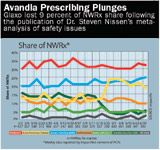
Avandia Prescribing Plunges
Physician Pulse-point What were doctors and their patients thinking? And how did the Avandia sales team and its competitors respond to the news? In addition to looking at NWRx, we surveyed 230 PCPs and 60 endocrinologists, with a screening criterion being any past Avandia prescribing.
Awareness was high. Nearly all the respondents (99 percent) had heard about the NEJM study showing Avandia's safety risks. But the survey showed that they were ambivalent about the data. On a seven-point scale, with 1 being not at all convincing and 7 being extremely convincing, PCPs recorded a cumulative score of 4.2. Endocrinologists were less convinced by the data, responding with a 3.4 score. In interviews, physicians said that they were happy with Avandia because the results seemed to outweigh the perceived risks. One physician questioned, "Isn't it ironic that the author of the study is the same doctor who helped bring down Vioxx?"
Rather, it seems that much of the switching was driven by patients' reactions instead of physicians' perception of the meta-analysis itself. (See "Patients React") When we asked doctors how their patients felt about the Avandia news on a 1 to 7 score, patient concern averaged a 5.9. Indeed, endocrinologist Robert Ruxin and internist Scott Andes explained on a Deutsche Bank/ImpactRx conference call for investors that they've been forced to respond to patient concerns fueled by hyped media coverage, despite their confidence in Avandia's safety and efficacy. As far as heart risk goes, Ruxin stated, "I am more concerned that people smoke, drink, and eat McDonald's as compared to the risks attributed to Avandia."
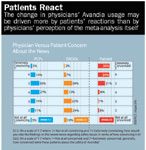
Patients React
Class in Session
On May 23, 2007, FDA requested that GSK and Takeda add black-box warnings to Avandia and Actos. Ironically, these warnings have nothing to do with the NEJM study of Avandia and the possibility that it increases heart attack and cardiac death. Rather, they focus on another, entirely different (but well-known) potential problem of the thiazolidinedione (TZD) class to worsen heart failure in patients.
FDA's request meant that it was taking a class approach to responding to the safety issues. But physicians were deciding for themselves whether they felt Avandia's safety issues were product- or class-specific.
For the doctors who were less concerned about class effect and may have believed the increased cardiac risk was product-specific, Actos was the clear winner. The share of switches going to Actos in primary care offices went from 11 percent in the week prior to almost 50 percent in the week immediately after the Avandia news. (See "Safety News Switch") Avandia's market share erosion was magnified further by the almost complete absence of new scrips being switched to Avandia from its competitors. In the weeks leading up to the event, Avandia accounted for more than 20 percent of all switches by PCPs.
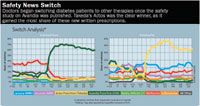
Safety News Switch
Physicians who were more concerned that Avandia's safety problems were a class effect turned primarily to Januvia. In fact, Deutsche Bank's Barbara Ryan predicted that Merck's Januvia was best positioned to reap the benefits of the NEJM announcement, with potential fiscal 2007 earnings per share increases of up to 9 cents. Indeed, Merck was able to capitalize on market events, having just launched a Januvia line extension, Janumet, in April. Instead of one brand cannibalizing the other, the Januvia franchise actually gained about four NWRx share points from Janumet's introduction, through the end of June.
Reps Play Defense and Offense
Of course, changes in treatment decisions don't happen in a vacuum. As doctors reacted to news about Avandia, companies sent in their reps to influence prescribing decisions. We surveyed our network of PCPs and endocrinologists to better understand this competitive landscape.
By far, GSK maintained the highest share of details among primary care physicians throughout the height of the Avandia news. (See "It's All in the Details") The company secured this access either through a "go on the offensive" initiative to counter-detail the NEJM article, or it was simply granted access based on the inherent desire of physicians to better understand the issue as relayed to them by a GSK rep. Sound bites recorded by our physician panel included "The rep returned again to discuss the recent news release on Avandia and the fact that Glaxo is standing behind their product, and offered us an 800 number to call."
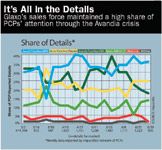
Its All in the Details
Interestingly enough, Takeda may have missed its chance to go on the primary care offensive. Based on the data, it seems the company may have been waiting to hear the outcome of the June 6 Congressional hearings that addressed Nissen's claims before launching a market offensive.
But when it came time to speak with endocrinologists, both GSK and Takeda took a strong share of detailing. In the week following the NEJM publication, Glaxo increased its share of physician-reported details from 27 to 39 percent, while Takeda's grew from 14 to 27 percent. It is likely that the companies dedicated this investment because endocrinologists are typically thought leaders and have a great influence over other physicians' prescribing behavior.
Doctors also granted access to Merck's Januvia reps, which probably helped drive the increase in that drug's prescribing. Januvia and Janumet's combined share of details with primary care physicians climbed from 32 to 39 percent in the weeks after the NEJM publication. It seemed that Merck was able to deploy a "SWAT-like sales force" immediately in light of the uncertainty surrounding TZDs, and the reps were greeted by physicians because they most likely wanted to hear about alternatives to Avandia.
Meanwhile, by the time Amylin/Lilly reacted to the news, it was too late for Byetta to capture its fair share of physicians' attention and the patients that were thrown into play.
Market Watch: Will Avandia Regain Its Footing?
The question of the day seems to be just how long Avandia's bad rep will last. To be sure, physician and patient concerns seem to be dissipating. PCP concerns on the news have moved from May's 4.2 score to 3.6, according to the findings of a second survey ImpactRx fielded in mid-June. The score for patient concern dropped from 5.9 to 5.2. In a follow-up call, Ruxin even said that he is "hearing nothing more from patients." Avandia's share of NWRx seems to have stabilized at about 6 percent, and GSK's share of details has dropped to prior levels. At press time, providers were poised, waiting for word from the FDA advisory meeting on July 30. FDA's actions coming out of that meeting are the next market test for TZDs.
Currently, strong opinions have been expressed on both sides of the Avandia safety issue. While the New York Times, on June 12, 2007, published an editorial stating FDA should have the power to demand adequate postmarketing studies, the Wall Street Journal stated a week later that the Avandia fuss is political—not medical—and that FDA already does too much onerous bottlenecking of new drugs. The scientifically level-headed practitioner will understand that the question of Avandia's safety will be resolved only with new analyses of existing data and more rigorous studies. This all will take time—much more time than the snapshot decisions patients make once they hear sound bites of bad safety news.
Richard Altus is the president and CEO of ImpactRx. He can be reached at raltus@impactrx.com.
The Misinformation Maze: Navigating Public Health in the Digital Age
March 11th 2025Jennifer Butler, chief commercial officer of Pleio, discusses misinformation's threat to public health, where patients are turning for trustworthy health information, the industry's pivot to peer-to-patient strategies to educate patients, and more.
Navigating Distrust: Pharma in the Age of Social Media
February 18th 2025Ian Baer, Founder and CEO of Sooth, discusses how the growing distrust in social media will impact industry marketing strategies and the relationships between pharmaceutical companies and the patients they aim to serve. He also explains dark social, how to combat misinformation, closing the trust gap, and more.
